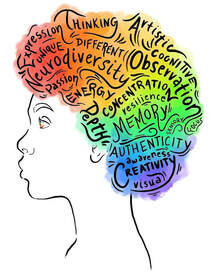|
As we become more educated and aware of what it actually means to be Autistic or ADHD, we are seeing more and more people meeting the criteria for these Neurological classifications. Specifically a lot of older teens and adults are learning that they are Neurodivergent. As individuals start to suspect they are neurodiverse, they do what most people do when they are curious about something… they google it. They may find themselves taking online questionnaires and then confused because perhaps they identify a lot with Autism… and then ADHD… and then maybe a few mental health disorders sprinkled in there… So which one is it??? Trying to distinguish between ADHD, Autism and other possible considerations and/ or diagnosises can be hard because of two distinct problems; co-morbidity and overlapping traits.
Co-morbidity is the scientific term for when multiple conditions or diseases are present simultaneously in an individual. Both ADHD & Autism are neurodevelopmental, meaning you are born with this neurological brain difference. However, many people who are Autistic have a collection of neurodevelopmental differences and one of those, quite frequently, is ADHD. Even when co-morbidity isn’t happening, autism and ADHD can display very similar, overlapping, traits. It’s important to look at the cause or circumstance. Both experience strong interests. These interests may be more limited to a small number of things for an autistic person, while Facebook groups like “ADHD Hobby Swap” have popped up for ADHD people to get rid of all the things they bought for their current hyper-fixation and move on to the next one. Both groups stim, but an autistic person will be doing so to self-sooth, express feelings or just because it is fun and someone who’s ADHD may be getting out excess energy or keeping themselves focused. Someone who is both Autistic & ADHD may find themselves somewhere in between, this tends to vary more. Finding a Neurodivergent affirming and informed therapist, doctor, psychologist, anyone who can diagnose, can be a good place to start when trying to figure out where you fit. They will be able to walk though your own personal examples to see if and what neurological classification fits best for you and/or if there is a mental health disorder that also could fit. For example, there is a lot of overlap between ADHD traits and PTSD symtoms. If this is not something accessible to you for one reason or another, I also want to state that self diagnosis is completley valid on a personal level. The thing is, even if you are wrong, if a self diagnosis gives you permission to be kind to yourself and to move through the world in a way that works for you and helps you to live more authentically and happily, then that is amazing. A note to the reader: I want to acknowledge that the current mental health diagnosis manual (DSM-5) identifies Neurological Classifications as Neurodevelopmental Disorders and uses a deficit model as a way of diagnosing Neurodiversities. The DSM is the book we must work with when it comes to providing accommodations and federally & state backed support. However, as we have seen countless times, the DSM gets a lot wrong and the editors of the DSM even acknowledge this in a general sense. This article works on trying to find a balance between educating the reader on the way we differentiate diagnoses in the DSM & educating the reader on Neurodiversity affirming language and perspective. Resources used: Is It ADHD or Autism? (2017, April 3). WebMD. https://www.webmd.com/add- adhd/childhood-adhd/adhd-or-autism Morin, A. (2021, April 2). The difference between ADHD and autism. Understood. https://www.understood.org/articles/en/the-difference-between-adhd-and-autism
1 Comment
DJ
5/14/2022 05:45:29 am
Very interesting and informative. I am a substitute teacher and noticed a couple of students who seemed both autistic and having ADHD. I gave one a squish ball and put him in the back and he played with it and was able to answer questions as well
Reply
Leave a Reply. |
Archives
June 2024
Categories |
Proudly powered by Weebly
Copyright © 2022



 RSS Feed
RSS Feed